Nasza Biblioteka Cyfrowa udostępnia 1 868 obiektów cyfrowych
Obiekt
Tytuł: Analysis of the Bearing Stress Caused by the Impact of Mechanical Fasteners on Quasi-Isotropic CFRP Composite ; Analysis of the Bearing Stress Caused by the Impact of Mechanical Fasteners on Quasi-Isotropic CFRP Composite
Tytuł odmienny:
Analiza nacisków wywołanych oddziaływaniem łączników mechanicznych na quasi-izotropowy kompozyt CFRP ; Analiza nacisków wywołanych oddziaływaniem łączników mechanicznych na quasi-izotropowy kompozyt CFRP
Współtwórca:
Jan GODZIMIRSKI, Marek ROŚKOWICZ ; Jan GODZIMIRSKI, Marek ROŚKOWICZ
Abstrakt:
This research aimed to determine the bearing strength of quasi-isotropic composites, considering their application in aircraft airframe repairs, and to investigate the influence of joint geometry on this strength. The research focused on a CFRP composite produced from a carbon prepreg. Specimens cut from the composite underwent static tensile testing to determine their tensile strength and modulus of elasticity. The effect of drilling a hole for a mechanical fastener on the composite material’s strength was examined. The influence of the hole’s distance from the specimen edge on the bearing stress and the maximum failure loads was investigated. The surface bearing stress in the composite under bolt load was determined, and tomographic tests were performed. Experimental studies were supplemented by numerical analysis, yielding stress distributions within the composite under fastener load. It was demonstrated that the failure load increases as the hole’s distance from the specimen edge increases. Furthermore, the reduction in composite material strength due to drilling was estimated at approximately 30%. The results highlight the importance of considering this strength reduction and maintaining appropriate rivet or bolt joint dimensions during the design of mechanical joints in composites.
;
This research aimed to determine the bearing strength of quasi-isotropic composites, considering their application in aircraft airframe repairs, and to investigate the influence of joint geometry on this strength. The research focused on a CFRP composite produced from a carbon prepreg. Specimens cut from the composite underwent static tensile testing to determine their tensile strength and modulus of elasticity. The effect of drilling a hole for a mechanical fastener on the composite material’s strength was examined. The influence of the hole’s distance from the specimen edge on the bearing stress and the maximum failure loads was investigated. The surface bearing stress in the composite under bolt load was determined, and tomographic tests were performed. Experimental studies were supplemented by numerical analysis, yielding stress distributions within the composite under fastener load. It was demonstrated that the failure load increases as the hole’s distance from the specimen edge increases. Furthermore, the reduction in composite material strength due to drilling was estimated at approximately 30%. The results highlight the importance of considering this strength reduction and maintaining appropriate rivet or bolt joint dimensions during the design of mechanical joints in composites.
Miejsce wydania:
Warszawa
;
Warszawa
Wydawca:
Wojskowa Akademia Techniczna ; Wojskowa Akademia Techniczna
Data utworzenia:
Data złożenia:
Data akceptacji:
Data wydania:
Rozmiar:
Identyfikator:
oai:ribes-88.man.poznan.pl:2736
Sygnatura:
doi:10.5604/01.3001.0055.1526 ; doi:10.5604/01.3001.0055.1526
ISSN elektroniczny:
ISSN drukowany:
Język:
Licencja:
kliknij tutaj, żeby przejść ; kliknij tutaj, żeby przejść
Właściciel praw:
Strona początkowa:
Strona końcowa:
Tom:
Czasopismo:
Słowa kluczowe:
mechanical engineering, CFRP composite, quasi-isotropic composite, mechanical joints, bearing stress ; mechanical engineering, CFRP composite, quasi-isotropic composite, mechanical joints, bearing stress
Kolekcje, do których przypisany jest obiekt:
Data ostatniej modyfikacji:
17 paź 2025
Data dodania obiektu:
17 paź 2025
Liczba wyświetleń treści obiektu:
0
Wszystkie dostępne wersje tego obiektu:
https://ribes-88.man.poznan.pl/publication/3077
Wyświetl opis w formacie RDF:
Wyświetl opis w formacie OAI-PMH:
| Nazwa wydania | Data |
|---|---|
| Analysis of the Bearing Stress Caused by the Impact of Mechanical Fasteners on Quasi-Isotropic CFRP Composite | 17 paź 2025 |
Obiekty Podobne
Paweł KOWALECZKO Andrzej PANAS, Mirosław NOWAKOWSKI1
Monika PRACHT Waldemar ŚWIDERSKI

